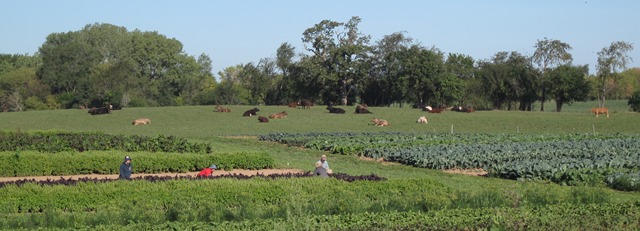What does it mean to manage an organization like a biodynamic farm? Biodynamic Association Co-Director Thea Maria Carlson talks about how we're learning to think of the BDA as an organism, as "a living system, an entity with its own energy, its own identity, its own creative potential and sense of direction."
A commercial industrial farm is a machine, but a biodynamic farm is a living organism. Guided by ecological, ethical and holistic principles, biodynamic farmers work to bring all the elements of their farms – crops, livestock, compost, soils – into right relationship, so that they balance and support each other, creating a self-sustaining whole.

The Biodynamic Association is the oldest sustainable agriculture organization in North America, and throughout our 77-year history we have sought the evolutionary edge in farming. We have also questioned how we might manage our nonprofit membership association more like a biodynamic farm – more like a living organism.
In his book Reinventing Organizations, Frederic Laloux describes an “evolutionary” and “soulful” organizational management model that closely parallels biodynamic farming. A “Teal” organization, as he calls them:
“… is viewed as a living system, an entity with its own energy, its own identity, its own creative potential and sense of direction. We don’t need to tell it what to do; we just need to listen, partner with it, join it in its dance, and discover where it will take us.”
After encountering Laloux’s work and the growing community of organizations who are adopting Teal, this year we decided to undertake our own transformation at the Biodynamic Association.
Drawing from in-depth research into the practices of over a dozen successful organizations, Laloux distills three core elements of Teal:
- Self-management: rather than a hierarchical structure where those at the top make decisions and pass them down, Teal organizations have a sophisticated yet simple way of organizing work that supports both individual freedom and effective collaboration.
- Wholeness: rather than expecting everyone to wear professional masks and check their intuition and feelings at the door, Teal organizations invite employees to show up as whole humans with the full range of their interests, talents, emotions, and needs.
- Evolutionary purpose: rather than priorities being dictated by the board or executives, Teal leaders recognize that the organization itself has a purpose to carry out in the world, which transcends the individual passions and ambitions of the people who make up the organization.
In April, we transitioned the Biodynamic Association to self-management, inspired by the Holacracy. We let go of our old job descriptions and supervisory relationships, and instead defined the specific activities that we each carry out to serve the needs of the organization. We grouped these activities into roles, with most staff members holding several roles to reflect the variety of contributions we make to the organization. Each person has the responsibility to discern the most important projects and actions to take within their roles, and to seek input from others who will be affected by their decisions. We have weekly tactical meetings to share updates, review metrics, and troubleshoot challenges together. We also have governance meetings where anyone can propose changes to a role or policy. Proposed changes go through integrative decision making process that honors every voice.
To foster wholeness, we begin every meeting with a moment of stillness, and a check in round to hear how each person is feeling and what’s on their mind. We have improved our offices with plants and standing desks, and have developed more flexible working hours and locations. We also recently held our first two-day staff retreat that was truly a retreat, not just a time to do intensive project-based or strategic planning work together. We gave ourselves space to be quiet in nature, reflect on our own inner work, and explore individually and together how we can continue to find more wholeness in our day to day work.
To explore evolutionary purpose, we use practices such as Otto Scharmer’s Theory U, which is designed to help us move from “ego” to “eco” awareness through deep listening and opening our hearts, minds and wills to collective and emergent wisdom. With both board and staff we make a regular practice tuning into where the organization wants to go through drawing, conversation, and interactive exercises.
While we are still at the beginning stages of our transformation, we have already felt a great increase in clarity and crispness around our work. There is an unleashing energy and curiosity among our staff and board, as well as many members of our association. We sense the soil beneath our work becoming richer, and see many ways we can keep improving. We look forward to seeing how this journey unfolds, and sharing what we learn along the way.